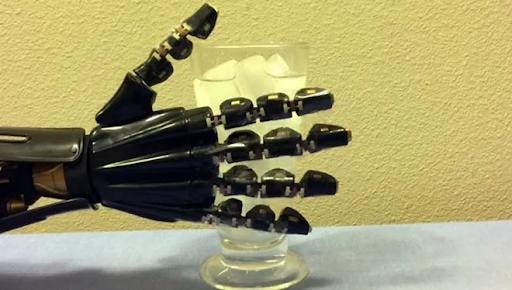This story is part of a series on the current progression in Regenerative Medicine. This piece discusses advances in prosthetic sensory feedback.
In 1999, I defined regenerative medicine as the collection of interventions that restore normal function to tissues and organs damaged by disease, injured by trauma, or worn by time. I include a full spectrum of chemical, gene, and protein-based medicines, cell-based therapies, and biomechanical interventions that achieve that goal.
New prosthetic technologies may allow amputees to feel real-time temperature sensations. In a study for Med, Dr. Jonathan Muheim and colleagues from the Neuro-X Institute describe a haptic system to provide amputees with controlled phantom thermal sensation. The system could be integrated into commercially available prosthetics, allowing the amputee to experience real-time dextrous thermal sensation. Here, I will analyze their discovery and discuss how it could impact the future of prosthetic development.
In the United States alone, over 41,000 people are upper-arm amputees, navigating life without the use of one or both hands. Aside from the mechanistic difficulties associated with upper limb loss, there are also thermal difficulties. Think of how often the hand or fingers are used as a temperature gauge, such as when cooking or taking a child’s temperature, among other things.
Interestingly, when an amputee loses a hand, they often feel lingering traces of thermal sensation as part of phantom hand syndrome, in which the nerves associated with the hand’s sensations continue to be active even after losing the hand.
By monitoring these phantom thermal sensations, Dr. Muheim and colleagues developed a personalized system they call MiniTouch to stimulate the residual arm and produce artificial temperature haptics from a prosthetic hand.
Over 130 days, the researchers closely monitored the phantom temperature sensations of a 57-year-old male patient without his hand for 20 years. In the 130-day period, the researchers mapped phantom thermal sensations to nerve endings on the residual arm.
From there, they integrated the thermal map MiniTouch system, which connected to active thermal skin sensors on a prosthetic hand. When the prosthetic touches a cold item, the MiniTouch stimulates the portion of the residual limb associated with coldness, relaying the temperature sensation to the brain.
To test the quality of their system, the researchers conducted several tests, including temperature discrimination, material discrimination, and bodily contact.
Temperature discrimination was conducted by having the amputee close the prosthetic on a bottle containing cold, room temperature, or hot water and then having the participant identify which was which. Throughout ten randomization, the participant was 100% accurate. In contrast, when the MiniTouch was off, accuracy dropped to 33%.
Material discrimination was tested by asking the participant to identify the material grasped by the hand, whether copper, glass, or plastic, using only temperature differentiation as a guide. While he only scored 67%, this matched the score of his intact arm, displaying a similar performance. Similarly, the participant was asked to touch four arms: two real, one prosthetic, and one rubber. Using surface temperature differences, the participant yielded 80%, which was below the 100% mark of his intact arm.
What I find to be the MiniTouch’s most crucial aspect is its significant integration upside. The system is not designed as a prosthetic, but rather an addition to existing prosthetics. This would also limit cost and boost accessibility for those who already have a prosthetic they prefer.
Further, there is an emotional aspect to regaining touch sensation. For some, taking your child’s temperature, feeling their skin, and transferring heat are emotional exchanges. Amputees lose more than an appendage. They often face social stigma and lack of connection. The MiniTouch is an opportunity to regain some of what was lost.
The ultimate goal of regenerative medicine is to harness the advances of the modern medical age to restore health and wellness in ways once thought impossible. The MiniTouch is a remarkable example, and I heavily anticipate its further development in the near future.
To read more of this series, please visit www.williamhaseltine.com
Read the full article here





